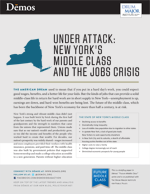The American Dream used to mean that if you put in a hard day's work, you could expect good wages, benefits, and a better life for your kids. But the kinds of jobs that can provide a solid middle-class life in return for hard work are in short supply in New York-unemployment is up, earnings are down, and hard-won benefits are being lost. The future of the middle class, which has been the backbone of New York's economy for more than half a century, is at risk.
New York's strong and vibrant middle class didn't just happen. It was built brick by brick during the first half of the last century by the hard work of our parents and grandparents and the strength in numbers that came from the unions that represented them. Unions made sure that as our nation's wealth and productivity grew, so too did the income and benefits of the people who worked hard to create that wealth. For decades, our nation's prosperity was widely shared-wages increased and more employers provided their workers with health insurance, pensions, and paid time off. The middle class was also built by government policies that supported homeownership and made a college education accessible to a new generation. Parents without higher education themselves proudly scrimped and saved to send their kids to college, made possible by affordable tuition at state universities and financial aid.
But all of this is changing and New York's middle class is in jeopardy. Once an example of smart policy choices and the home of a thriving manufacturing sector and a stable middle class, the state has been caught in a downward spiral that mirrors unfortunate national trends. Not only did the Great Recession cost the state 398,000 jobs, but the economic effects of those lost jobs reverberated to all corners of the state, particularly the already-strained finances of the state government. We estimate that the jobs lost due to the recession have cost Albany over $1 billion annually in direct lost sales and income tax revenues, on top of other revenue losses from the recession, putting thousands more middle-class jobs at risk. If the state's unemployment rate were at pre-recession levels, that lost billion would return to the state government's coffers and could be used to help thousands of young people attend college, maintain dozens of state parks, or hire, for example, as many as 10,000 teachers or 9,600 nurses. These lost and endangered jobs, in turn, will only exacerbate the extreme income inequality that has defined New York for decades, and managed to coexist for decades with the state's thriving middle class.
One bright spot, however, is New York's relatively high rate of unionization which mitigates the state's inequality, helping to secure middle-class jobs in an economy increasingly divided between well-paid professionals and everyone else. Yet unions' mitigating power has sharp limitations: retail sales, the restaurant industry, and other service jobs remain largely nonunion. Not coincidentally, these sectors offer low wages and few benefits. Unfortunately, they are also among the fastest growing areas of the state's economy, a trend which may accelerate as the state cuts back its support for better-paid sectors like health care and education and continues to lay off middle-class public employees.
New York's best hope lies in the potential for smart public policy to strengthen and expand the state's mid- dle class. Renewed state investment in critical public goods like education and transit infrastructure would cultivate middle-class jobs while at the same time improving New Yorkers' mobility and access to quality education. Reauthorizing and strengthening New York's rent laws would help ensure that families could afford to remain in New York City. The recent passage of promising legislation, such as the first-in-the-nation Domes- tic Workers' Bill of Rights, and the Wage Theft Prevention Act suggests that New York continues to take the concerns of working people seriously and may yet step up to the plate to bolster its faltering middle class.
